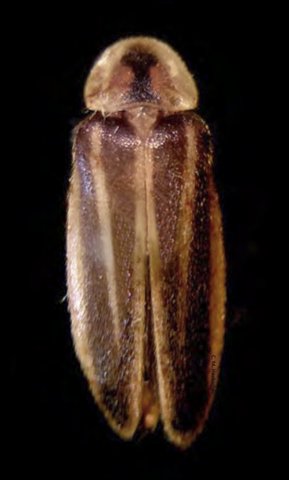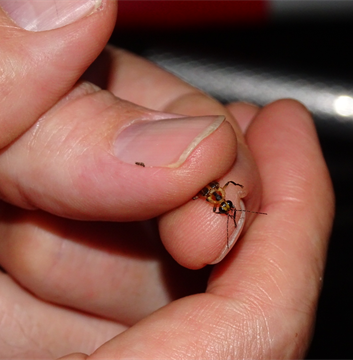Appearance
The Bethany Beach firefly (Photuris bethaniensis) is a small firefly measuring 9.0-10.75mm long. It has a tan to light brown body, with dark brown or black markings. While physically similar to many other lampyrids (fireflies), the Bethany Beach firefly has a distinctive flash pattern of two green flashes, also called a double-green flash pattern. While not all firefly species flash, the ones that do produce orange, yellow or green light in a variety of flash patterns. It is thought that firefly species evolved to have different flash patterns so that females can distinguish males of their species in areas where multiple species coexist.
What does it eat?
Firefly larva are carnivorous or omnivorous. They are active hunters and catch other arthropods, mollusks and annelids. They will also scavenge. Some species also consume fallen fruit. While most adult fireflies do not eat, female Photuris fireflies (including the Bethany Beach firefly) mimic the flash patterns of males of other species to attract and consume them!
Where and when do you find them?
Bethany Beach fireflies are endemic to the Delaware coast. They do not inhabit Minnesota. So why bother featuring them here? Many firefly populations globally are believed to be in decline. The Bethany Beach firefly was petitioned to be listed as federally endangered under the Endangered Species Act in 2019 and is the first firefly to be considered for listing! Thus, this firefly is important from a conservation perspective—as scientists begin to think about how to conserve fireflies, the practices they learn for the Bethany Beach firefly could also inform conservation of our fireflies here in the Midwest.
Bethany Beach fireflies are habitat specialists found only in freshwater interdunal swale habitats within 500 m of the Delaware coast. These habitats are low-elevation marshy areas located between sand dunes along the coast. They are at risk of saltwater intrusion from storm surges and rising sea levels. This narrow habitat requirement makes conserving the Bethany Beach firefly challenging, particularly given that fireflies are generally weak dispersers. The adults are active from June through August. Virtually nothing is known about their larva—in fact, no one has ever confirmed seeing a Bethany Beach firefly larva!
Not-So-Fun Fact
Recently, a wetland habitat with the largest known population of Bethany Beach fireflies was lost due to development in Breakwater Beach. A developer found a creative loophole in the policy that protects designated wetlands. They built an elevated roadway and cul-de-sac on pilings rather than filling in the wetlands. While this construction adheres to environmental regulations, the firefly population that inhabited this wetland is essentially lost.
More information:
https://www.doverpost.com/news/20191227/bethany-beach-firefly-lights-out
Author
Michelle Boone
Photo credit
Christopher Heckscher (first photo)
Second photo courtesy of the U.S. Fish and Wildlife Service



